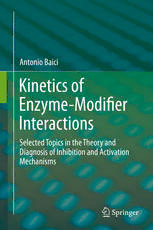Table Of ContentAntonio Baici
Kinetics of
Enzyme-Modifi er
Interactions
Selected Topics in the Theory and
Diagnosis of Inhibition and Activation
Mechanisms
Kinetics of Enzyme-Modifier Interactions
Antonio Baici
Kinetics of Enzyme-Modifier
Interactions
Selected Topics in the Theory and Diagnosis
of Inhibition and Activation Mechanisms
123
AntonioBaici
DepartmentofBiochemistry
UniversityofZurich
Zurich,Switzerland
ISBN978-3-7091-1401-8 ISBN978-3-7091-1402-5 (eBook)
DOI10.1007/978-3-7091-1402-5
LibraryofCongressControlNumber:2015942930
SpringerWienHeidelbergNewYorkDordrechtLondon
©Springer-VerlagWien2015
Thisworkissubjecttocopyright.AllrightsarereservedbythePublisher,whetherthewholeorpartof
thematerialisconcerned,specificallytherightsoftranslation,reprinting,reuseofillustrations,recitation,
broadcasting,reproductiononmicrofilmsorinanyotherphysicalway,andtransmissionorinformation
storageandretrieval,electronicadaptation,computersoftware,orbysimilarordissimilarmethodology
nowknownorhereafterdeveloped.
Theuseofgeneraldescriptivenames,registerednames,trademarks,servicemarks,etc.inthispublication
doesnotimply,evenintheabsenceofaspecificstatement,thatsuchnamesareexemptfromtherelevant
protectivelawsandregulationsandthereforefreeforgeneraluse.
Thepublisher,theauthorsandtheeditorsaresafetoassumethattheadviceandinformationinthisbook
arebelievedtobetrueandaccurateatthedateofpublication.Neitherthepublishernortheauthorsor
theeditorsgiveawarranty,expressorimplied,withrespecttothematerialcontainedhereinorforany
errorsoromissionsthatmayhavebeenmade.
Printedonacid-freepaper
Springer-VerlagGmbHWienispartofSpringerScience+BusinessMedia(www.springer.com)
To mystudents,SwissFederalInstituteof
TechnologyandUniversityof Zurich,
1972–2012
Foreword
Manydrugsincurrentuseowetheireffectivenessto thefactthattheyareenzyme
inhibitors.Inaddition,goingbacktothestudiesofinvertasethatLeonorMichaelis
andhiscollaboratorscarriedoutatthebeginningofthetwentiethcentury,inhibitors
haveplayedamajorroleineffortstounderstandthemechanismsthatallowenzymes
to fulfil their roles as catalysts. Bringing these two aspects together, we may note
that understanding how inhibitors affect individual enzymes is a necessary step
in understanding what happens when an enzyme that forms part of a metabolic
pathway is inhibited in a living organism.Inhibitorsand activators taken together
are classified as enzyme modifiers, the subject of Antonio Baici’s masterly book.
Activatorshavebeenlessintensivelystudiedthaninhibitorsovertheyears,butthey
arealsoimportantandshouldnotbeforgotten.
It surelyfollows,therefore,thatkineticcharacterizationof these effectsis vital
both for understanding enzyme mechanisms and for drug development. Yet the
treatment in most general textbooks of biochemistry (with Henry Mahler and
EugeneCordes’sBiologicalChemistry,nowmorethan40yearsold,asanhonorable
exception) is nearly always superficial and sometimes even misleading. More
specialized books on enzymes mostly do little more than scratch on the surface,
though again there is an honorable exception, in the form of Malcolm Dixon and
EdwinWebb’sEnzymes.Someofthebooksspecificallydevotedtoenzymekinetics,
suchasIrwinSegel’sEnzymeKinetics,includeconsiderabledetailaboutinhibition,
though not all of them do. Few of the better books are very recent, however, and
J. Leyden Webb’s monumental treatise Enzyme and Metabolic Inhibitors dates
from the 1960s. Many of today’s readers are unlikely to know that it even exists,
especially if they do all their reading on the web, or if they think that nothing
publishedmorethan6monthsagoisworthreading.
ThesystematictreatmentofinhibitionandactivationbyJeanBottsandManuel
Morales [Transactions of the Faraday Society 49, 696–707 (1954)] is even older,
and the principles they set out are now rarely taught. In the distant past, when I
used their theoryas the basis of teaching aboutenzyme modifiers, it was obvious
thatitwasveryunpopularwithstudents,beingseenashighlycomplexanddifficult.
As Antonio Baici shows, however, it can be presented in a way that allows it to
vii
viii Foreword
be understoodand applied.Moreover,it neededto be extendedto take accountof
allostericeffects,whichwereessentiallyunknowninthe1950s.
Biochemistswhobelieveinthecomfortingillusionthatanyinhibitorthathasa
structuralresemblanceto thesubstrate ofthe enzyme,andevenonethatdoesnot,
canbetreatedasasimplecompetitiveinhibitorwillfindabundantevidenceinthe
bookthatitisjustthat,anillusion.Theauthorprovidesmanyexamplesofthekinds
ofbehaviorthatpeoplemightprefernottoknowabout,andshowsthatbuildingon
BottsandMorales’spioneeringworkisnecessaryforanadequateunderstandingof
enzyme modifiers. That in turn is necessary if one hopes to design inhibitors and
activatorsthatwillbepharmacologicallyuseful.
Marseille,France AthelCornish-Bowden
March2015
Preface
Thismonographisneitheraimedatcoveringalltechnicalaspectsofenzymekinetics
nor at reviewing extensively enzyme inhibition and activation. Considering that
fundamentalaspects of enzyme kinetics have been competently treated in several
books,whilecountlessreviewsandarticlesdealtwithspecifictopics,Iassumethat
readers of Kinetics of Enzyme-Modifier Interactions are already familiar with the
basic principles of this discipline. My last thought while writing this book was
to deal with pièces de résistance in the classical way found in existing excellent
publications by copying and pasting established theories and methods, a bare
nonsense.Rather,I feltthat ourknowledgeofenzyme-modifierinteractionscould
benefitfromascrutinyofexistingbutinawayburiedconceptsinneedtobeclarified
and complemented by systematization using alternative methods. Therefore, the
following chapters will examine under a magnifying glass selected topics and
discuss less-known, neglected, or overlooked aspects by adding a pinch of new
ideas.Thegoalistosupportinvestigationsinvitrobysuggestinglogicalsolutionsto
problemsofvariouscomplexityanddevelopingtheoreticalaspectsofmechanisms
beyond those already known but likely to exist in still unexplored niches. An
extensiontolivingorganismstoincludethefluxcontrolinwholesystems,through
modificationofaparticularenzyme,liesoutsidetheobjectivesofthisbook.
To discredit the rumor about enzyme kinetics as an abstruse discipline, the
studentsinmyundergraduatecoursesweremotivatedbylecturesinenzymekinetics
thatincludedmaterialpresentinthisbook.Studentsinmaster’sdegreeprogrammes
graspedquicklythevariousmechanismsofenzymeinhibitionandactivation,double
inhibition, and slow-onset inhibition. Therefore, not being complicated as it may
appearatfirstsight,thisbookishopedtoinspireteachers,students,andinvestigators
inacademiaandindustryinterestedinexploringthestillpartlyunchartedterritory
ofenzymemodification.
Apossiblenoveltytostudentsofkineticsisthesystematicapproachtoenzyme
modification mechanisms, which will be ranked taxonomically following criteria
basedonindividual,uniquecharactersthatmakethemequaltospecies.Similarto
plantsandanimals,to whichsystematic namesaregiventodistinguishthemfrom
other related or unrelated species, also enzyme-modificationmechanisms deserve
ix

